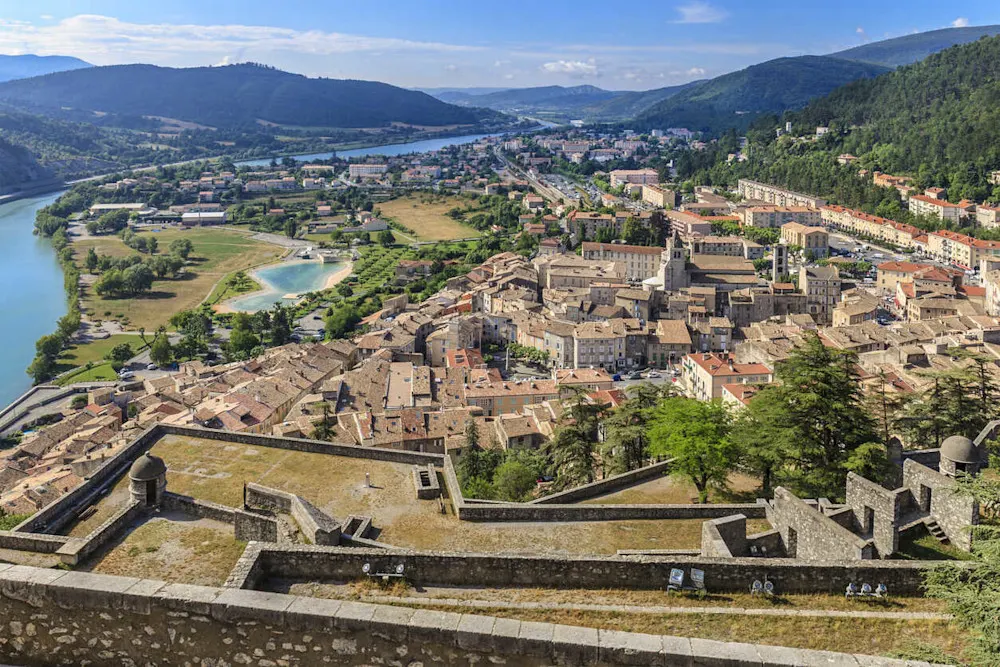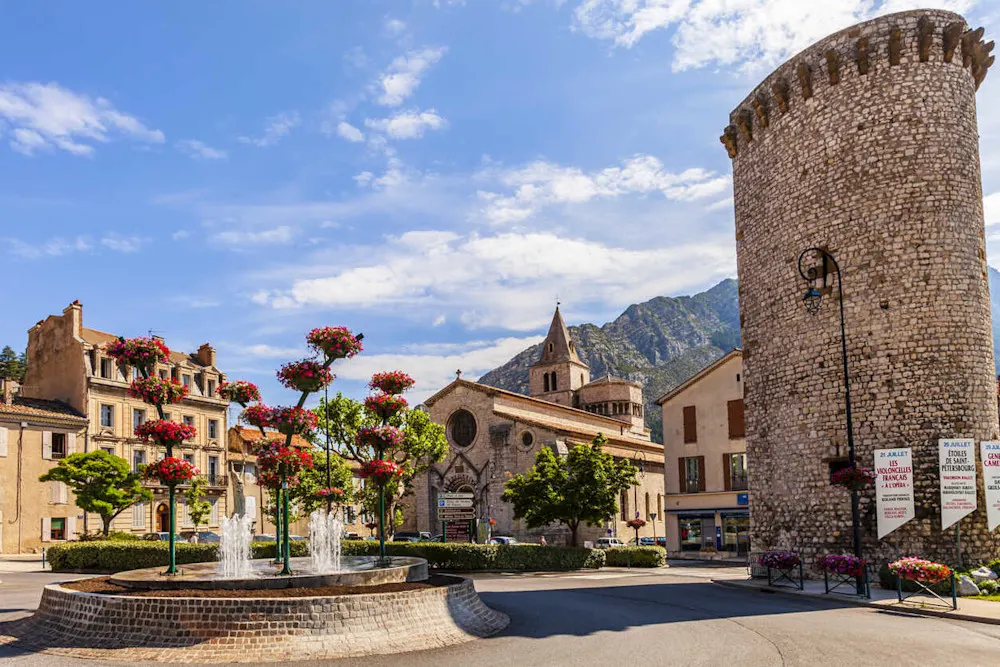When I first saw a photo of Sisteron, I knew I had to go there and see it for myself. It was an impossibly vertical mountain, sculpted from gigantic vertical folds of rock with a high-arched cave in the middle, like the entrance to some secret realm from a mythical epic—Lord of the Rings, perhaps. Teresa (my beloved spouse) was skeptical that Sisteron was even real.
"It’s not in any of my guidebooks," she told me, flatly.
Was this perhaps an Internet hoax? I assured her no. Well, then maybe the town was too dull for the guidebooks… too dull to merit the long drive through the Alps. No, I insisted, sounding to even myself like a man obsessed. The land of the elves is real, I tell you! In the end, I prevailed, accepting the risk of "I told you so" from my beloved if Sisteron turned out to be a dud.
Get Your Free France Report Here
Get Your Free France Report Here
Learn more about France and other countries in our daily postcard e-letter. Simply enter your email address below and we’ll send you a FREE REPORT: A Taste of France: All the Ingredients for the Good Life.

By submitting your email address, you will receive a free subscription to IL Postcards and special offers from International Living and our affiliates. You can unsubscribe at any time, and we encourage you to read more about our Privacy Policy.
Located on the border between Provence and the Haute Alps, Sisteron bills itself as the "Gateway to Provence." The massive limestone ridge that defines the town forms a natural choke point on the Durance River. Since before Roman times there has been a fort on this site — followed later by a castle and citadel.
And yet, as we drove upriver into the pleasant little town, that impressive view of the mythical mountain was simply nowhere to be seen. Teresa gave me side eye. We could see a medieval castle from the window of our B&B, and right across the street was a 12th-century cathedral, Our Lady of the Apple Trees. But, ho hum, it seems every hill town in Provence has the same two features.
We unpacked, then struck out through the winding, cobbled streets of the old town, passing blocks of cute shops and enticing restaurants, and a Romanera history museum. Finally, we came to the bank of the Durance, just as the sun was setting.

It was real, this mountain, and in the fading sunlight, it was glorious. Its Provençal name, Rocher de la Baume, means "Rock of the Cave," but that does not begin to do justice to the geology of it. Those gigantic vertical slabs of rock are actually a prehistoric seabed—layers of coral and sediment that hardened into limestone in the Jurassic Era.
As Africa slowly collided with Europe—creating mountain size ripples that became the Pyrenees and the Alps—Provence rose above sea level. Around Sisteron, the ground buckled and twisted up into a ridge, upending a strip of the ancient limestone seabed and pushing it over onto its side. Imagine cutting a slice of layer cake and then tipping it sideways onto your plate; the horizontal layers now run vertically up and down. That’s what happened at Sisteron.
Over the next few million years, erosion — wind, water and especially glaciers — scoured away the softer layers of sediment, etching the harder limestone layers in sharp relief and gouging out the mysterious hooded cave between its massive folds.
One side of the Rock (originally the bottom, if you keep our layer cake analogy in mind) is very roughly about a hundred million years older than the other (the top layer). Gazing at the mountain, I could not tell at all which side was older, which younger. But neither could scientists—they had to analyze the fossil shells embedded in those ancient sea beds.
The next day we crossed the bridge over the Durance and walked right up to the base of the Rocher de la Baume. A large wire net covered the entrance to the cave to prevent rocks from falling down on the houses below (and hapless tourists from wandering inside and getting conked on the head). But the entrance to the large open cleft on the far right of the mountain was unimpeded. Teresa prudently waited by the edge while I walked inside the narrow canyon. Deep in that limestone layer cake, with just a thin bar of blue sky visible high above my head, I felt very vulnerable. (Thinking about that potential conk on the head from a falling rock.) At Teresa’s urging, I quickly hurried out again.
The rock face is in fact stable enough to scale —we noticed climbers (in helmets) on the edge of the ridge. Apparently, there are 100 routes up the Rocher de la Baume, some suitable for beginners, others requiring advanced technical skills. For hikers who prefer a less vertiginous path to the top, there are trails winding up the mountain’s flanks.
Sisteron’s other main tourist draw is the castle on the opposite bank of the river, where the huge limestone ridge continues. We had a magnificent view of its outer walls from our B&B window—the castle is so high up, it’s visible from most places in town. It looks massive from the ground, which is an optical illusion, because the limestone ridge is so narrow at the top that the castle is actually rather skinny. When we climbed it ourselves, we discovered that we could touch both walls as we walked the length of the upper parapet.
I especially appreciated the unique audio-info sites inside the grounds that told the story of the castle in five different languages. Rather than a pundit’s dull recitation of historical facts, we heard the the castle itself: a gentle but world-weary feminine voice that told us of her rise to prominence from a Roman fort, the bloodshed she witnessed through the turbulent Middle Ages, her numerous destructions and reconstructions, and now, in old age, her simple longing for peace…
The most dramatic event the castle told us about was in March 1815, when Napoleon and his troops arrived at Sisteron. The former emperor of France had been exiled to the Island of Elba but he’d escaped and—with a gathered army of 1200 loyal soldiers—marched north towards Paris, aiming to retake all of France. That path took him straight across Sisteron’s narrow bridge. History would have been different if the soldiers defending the bridge had fired. But Napoleon’s army was allowed to cross unmolested.
When they passed safely to the other side, Napoleon is said to have exclaimed, "Now, I am in Paris!"
The Town Also Rocks

These two rock wonders — the Rocher de la Baume and the Castle of the Counts of Provence — one made by nature, the other by human hands — are the most dramatic sites to see in Sisteron.
However, I was equally captivated by the town itself. Mostly, I enjoyed the contented workaday vibe. There was some kind of local festival going on the weekend we were there. Amusement rides had been set up in the town square. We strolled around and watched kids eat cotton candy, shrieking on the various spinning rides and in fun houses under the grey aegis of the castle.
Saturday afternoon, we heard a brass band playing. Following the sound, I arrived at a parking lot that had been turned into an outdoor concert hall. About forty musicians sat on folding chairs beneath the town clock tower. They all wore white shirts and black pants; some were teenagers, others were senior citizens—obviously, the local band. They struggled a bit to keep time, but with passionate gestures the conductor drew out their best possible performance. This was not for the tourists. This was just for them. Just for the fun of it, on a sunny spring afternoon in Sisteron.
Provence has many medieval villages, but too often their authenticity is eroded by excessive tourism. Souvenir shops replace the butcher and baker. Residents turn their old row houses into Airbnbs. With so many homes turned into rentals for vacationers, the villages become hollow replicas of themselves: zombie towns that are full of people yet empty of life.
That has not happened in Sisteron. It’s a town with refreshingly light tourist infrastructure: a couple of hotels, a handful of B&Bs, and several very good restaurants. In fact, for French people, the area’s real draw is neither its history nor geology, but the famously succulent Sisteron lamb. (Teresa and I ate lamb for dinner every evening we stayed in Sisteron, and it was délicieux.)
It’s a bit too far from the main tourist sites of Provence—Avalon, Aix, and the Côté d’Azur—for an easy day trip. And the road through Sisteron is no longer the fastest way to get to Paris from the south (a modern-day Napoleon would take the A8-A7 expressways via Lyon). You have to want to come to Sisteron to see it for its own sake.
Like us, you might come for the mountain, but you’ll be glad you stayed for more than a day: for the castle, the community, and the lamb.
Get Your Free France Report Here
Get Your Free France Report Here
Learn more about France and other countries in our daily postcard e-letter. Simply enter your email address below and we’ll send you a FREE REPORT: A Taste of France: All the Ingredients for the Good Life.

By submitting your email address, you will receive a free subscription to IL Postcards and special offers from International Living and our affiliates. You can unsubscribe at any time, and we encourage you to read more about our Privacy Policy.
